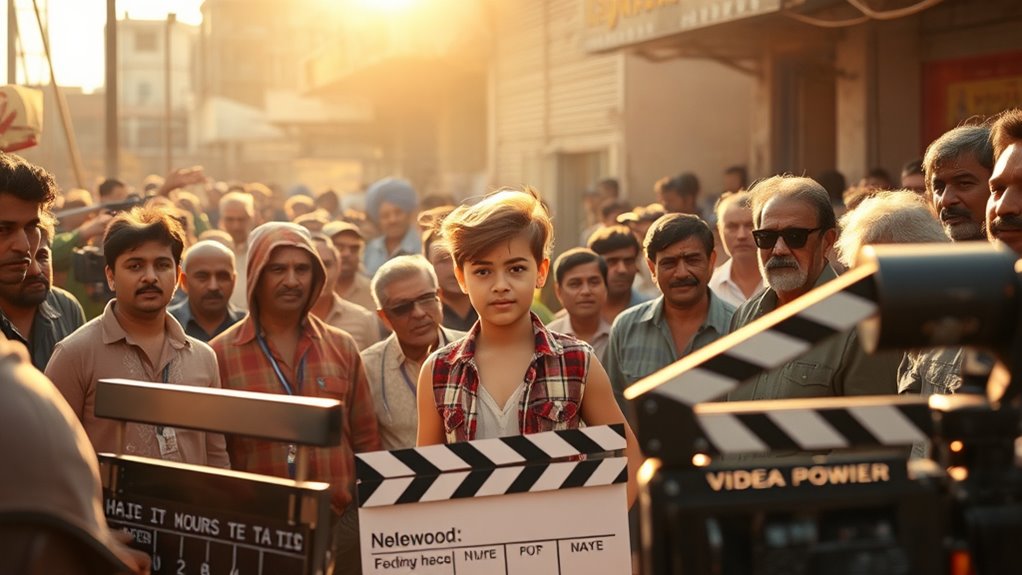Nepotism still plays a strong role in Bollywood, with star kids dominating key roles despite public criticism. Industry practices favor family connections, helping star kids secure opportunities even with limited experience. While many audiences prefer talent over lineage, star kids continue to influence box office success. Recent scandals and reforms aim to promote fairness, but the dominance persists. If you’re curious about how the industry is evolving, you’ll find more insights ahead.
Key Takeaways
- Despite ongoing debates, over 60% of lead roles from 2015-2023 went to star kids, maintaining industry dominance.
- Public opinion remains divided, with many viewers advocating for merit-based casting over family connections.
- Recent high-profile debuts of star kids continue to spark discussions about nepotism’s influence.
- Industry reforms and digital platforms are gradually promoting diverse talent, challenging the traditional star kid dominance.
- While star kids still hold significant industry presence, emerging talent and audience preferences are shifting power dynamics.
The Roots and Evolution of Nepotism in Bollywood

Nepotism in Bollywood has deep roots that trace back to the industry’s earliest days. After Partition, many families migrated to Bombay, drawn by its cosmopolitan vibe, and quickly established early film dynasties. During those times, cinema was stigmatized, so prominent families provided much of the initial talent and created production houses to launch their children’s careers. Pioneering families like the Kapoors and Chopras built dynasties, controlling casting, production, and distribution across generations. This consolidation of power meant influence remained within family networks, ensuring a continuous hold over the industry. Roots of nepotism also draw from Indian kinship traditions and the culture of stardom, where family ties often became a strategic tool for managing risks and maintaining industry dominance. Additionally, the tradition of passing down heritage and reputation has reinforced the prevalence of nepotism in Bollywood. The persistence of industry influence within families has contributed to the ongoing dominance of star kids, despite evolving industry dynamics.
How Nepotism Shapes Talent and Box Office Results

How does the favoritism toward industry insiders influence talent development and box office success? When nepotism dominates, opportunities for fresh talent become scarce, favoring those with family connections. This often results in a limited talent pool, reducing the diversity of skills and perspectives in the industry. You’ll notice that star kids often land leading roles despite limited experience, which can hinder genuinely talented outsiders. This practice limits diversity and discourages innovation within the industry. Casting decisions frequently favor star kids, boosting box office potential through their existing fan base and name recognition, but they also invite scrutiny and criticism. Behind the scenes, industry insiders with family ties gain easier access to funding, distribution, and influential networks. Additionally, the role of contrast ratio in projectors underscores how visual quality impacts audience engagement, just as casting choices influence viewer perception in films. Interestingly, the dominance of star kids can sometimes lead to a lack of fresh perspectives in storytelling, impacting the industry’s evolution. Moreover, nepotism can create an environment where meritocracy is undervalued, limiting the overall growth of the industry. While films with star kids may perform well initially, negative perceptions of nepotism can lead to backlash, impacting long-term box office outcomes. India’s film industry is one of the largest globally and has a significant influence on the cultural landscape, further amplifying the effects of nepotism.
Audience Attitudes and Perceptions Toward Industry Favoritism

Many audiences are aware of the widespread presence of favoritism in Bollywood, and this knowledge influences how they perceive and engage with the industry. Most recognize nepotism’s prevalence, especially after high-profile incidents and media coverage. Over 60% of urban Indians view nepotism unfavorably, believing it limits opportunities for outsiders and stifles diversity. While one-third of audiences say nepotism hasn’t yet influenced their film choices, nearly a quarter actively avoid movies featuring star kids. Still, many prioritize story quality and acting talent over family connections. Younger viewers tend to be more skeptical and support merit-based casting, whereas older audiences remain more accepting of star kids. Public opinion also considers the impact of this favoritism on industry diversity and fairness. The perception of blatant favoritism has fueled ongoing debates about fairness and equal opportunity in Bollywood. The influence of industry dynamics continues to shape public attitudes and industry practices. Overall, public opinion leans toward calling for transparency and reform to create a fairer industry. Nepotism’s impact continues to be a topic of debate, with many advocating for systemic changes to promote a more equitable environment. Additionally, awareness of industry practices, such as the role of home furnishings in creating comfortable and functional living spaces, can influence future perceptions and reforms.
Recent Incidents and Public Discourse Around Nepotism

Recent events in Bollywood have brought renewed focus to the ongoing debate over industry favoritism. You’ve seen star kids like Shanaya Kapoor, Rasha Thadani, and Aryan Khan debut in high-profile projects, sparking widespread discussion. The release of ‘The Archies’ and Aryan’s directorial debut attract both praise and criticism, highlighting industry biases. The industry’s reliance on star kids has worsened over the years, with over 60% of lead roles from 2015-2023 going to star children, which many believe hampers fresh talent from emerging. Key points include: 1. The media and social media amplify debates, with hashtags questioning meritocracy. 2. Public backlash targets studios for promoting star kids over talented outsiders. 3. Industry insiders defend nepotism, citing audience preferences and legacy success. These incidents keep the discourse alive, fueling ongoing conversations about fairness and access within Bollywood’s power structure. The dominance of star kids also impacts educational opportunities for aspiring actors outside the industry, further entrenching existing inequalities. Additionally, the prevalence of nepotism can influence casting decisions, often sidelining talented outsiders in favor of industry insiders. This pattern is reinforced by industry dynamics, which tend to favor established names and familial connections over new entrants.
Industry Insights and Statistical Perspectives

Industry insights reveal that perceptions of nepotism markedly influence Bollywood’s image and audience behavior. The Bollywood Image Report 2024 shows ongoing debates about nepotism’s role, with many perceiving it as a barrier to meritocracy and fresh talent. Audience views are shaped by social and traditional media, linking nepotism to the rise of star kids from film families. While about 34% of urban Indians say nepotism doesn’t affect their choices, nearly 24% oppose it entirely, especially older viewers. Recent box office trends highlight failures of star kid-led films, eroding trust in industry fairness. Despite ongoing scrutiny, 15 prominent star kids are active in 2025, continuing to dominate headlines. These statistics underscore how nepotism remains a contentious and influential factor shaping Bollywood’s current landscape. Additionally, ongoing discussions emphasize the importance of smart industry practices in fostering genuine talent and merit-based success. Implementing transparent evaluation systems can help address concerns about fairness and promote diverse opportunities within the industry. Furthermore, understanding the impact of automation in business could provide new avenues for talent assessment and development beyond traditional star kid pathways. Recognizing the influence of tableware in social settings could also shed light on cultural perceptions of status and success within the industry. Moreover, the integration of necessary cookies can help improve industry transparency by enabling better data collection and analysis of industry trends.
The Future of Bollywood: Challenges and Opportunities Amid Nepotism

You have the chance to shape Bollywood’s future by supporting new talent and pushing for industry reforms. Overcoming nepotism requires embracing fresh voices and innovative ideas that can appeal to modern audiences. By doing so, you can help create a more diverse and dynamic industry poised for growth. Recognizing the evolving industry dynamics, emerging filmmakers are increasingly gaining recognition and changing traditional narratives, indicating a shift towards greater inclusivity. Incorporating AI-driven storytelling techniques can also open new avenues for creative expression, further enriching the industry’s diversity.
Embracing New Talent
Despite the dominance of star kids, Bollywood is witnessing a promising surge of fresh talent making their mark through digital platforms, music videos, and independent films. You’ll see more outsiders gaining recognition before their cinema debuts, thanks to online audiences and diverse casting choices. Film studios are now investing in original talent to diversify their rosters and find new stars. Here are key ways Bollywood is embracing new talent:
- Digital platforms like OTT and YouTube provide low-barrier entry for aspiring actors.
- Independent films and content-driven cinema open doors for versatile performers.
- Music videos and web series serve as proving grounds for emerging talent.
- Statistics show a significant increase in the number of young actors gaining popularity through social media and streaming services, indicating a shift in how new talent is discovered and celebrated.
This shift not only celebrates fresh faces but also reflects changing audience preferences for acting skills and relatability over lineage.
Industry Reforms Ahead
As Bollywood faces mounting financial pressures, reforms are becoming essential to guarantee its survival and growth. You need to focus on rationalizing budgets, reducing star fees, and encouraging innovative content to attract audiences. High star salaries and costly productions have led to many films flopping despite decent box office results. Industry insiders suggest controlling costs and exploring fresh storytelling to stay competitive. The table below highlights key reform areas:
| Challenge | Solution | Opportunity |
|---|---|---|
| Rising production costs | Budget rationalization | Reclaim theatrical dominance |
| Star fee inflation | Talent diversification | Broader casting choices |
| Audience engagement | Content innovation | Attract new viewers |
Frequently Asked Questions
How Do Nepotism Practices Vary Across Different Regional Indian Cinemas?
You’ll notice that nepotism varies across regional Indian cinemas. In Bollywood, it’s quite prominent, often favoring star kids. But in South Indian and Marathi cinemas, talent and story matter more, so nepotism is less obvious. These industries focus on merit, giving more chances to newcomers. You might find regional films more diverse and fresh, as they emphasize skill over family connections, making them more appealing to audiences seeking genuine talent.
What Legal or Policy Measures Could Address Nepotism in Bollywood?
Ever wondered how to level the playing field in Bollywood? You can support policies like mandatory open auditions, independent oversight, and transparent reporting standards that put talent above family ties. Enacting anti-nepotism laws, protecting whistleblowers, and encouraging blind casting can act as shields against favoritism. These measures, combined with industry-led initiatives and data-driven audits, help guarantee that merit shines through, breaking the cycle of nepotism and fostering true industry diversity.
Are There Successful Outsider Actors Challenging Star Kids’ Dominance?
You see outsider actors challenging star kids’ dominance in Bollywood. Vicky Kaushal, Kartik Aaryan, and Ranvir Shorey prove that talent and perseverance can break through industry barriers. They’ve gained recognition despite limited connections, showing that success isn’t solely about nepotism. While star kids often get early opportunities, outsiders are now carving their paths, earning respect and challenging the traditional hierarchy with their skills and dedication.
How Does Nepotism Impact Diversity and Representation in Bollywood?
Imagine Bollywood as a garden where only certain seeds are nurtured, leaving others to wither unseen. Nepotism acts like a gatekeeper, limiting diverse voices and fresh talent. You notice fewer stories reflecting different cultures or perspectives, narrowing the industry’s colors. This bias stifles growth, making Bollywood less vibrant and inclusive. As opportunities concentrate among star kids, many talented outsiders remain hidden, risking the industry’s future and its ability to truly represent its diverse audience.
Can Bollywood’s Reputation Recover From Ongoing Nepotism Controversies?
You wonder if Bollywood’s reputation can bounce back from nepotism scandals. It’s possible if the industry embraces transparency and fairness, giving outsiders genuine opportunities. You can support change by choosing films that highlight merit and diverse talent, encouraging industry leaders to reform hiring practices. While challenges remain, your voice matters. If more people demand accountability and merit-based growth, Bollywood can regain trust and rebuild its image over time.
Conclusion
As you watch Bollywood’s glimmering screens, it’s easy to see how nepotism’s shadow lingers, much like a familiar face in a crowded room. Despite the flashes of new talent, star kids often seem to step into the spotlight as if guided by an unseen hand. Yet, just beyond the spotlight, fresh voices await their turn, promising that someday, the industry’s story might rewrite itself, revealing a more inclusive, vibrant future.









